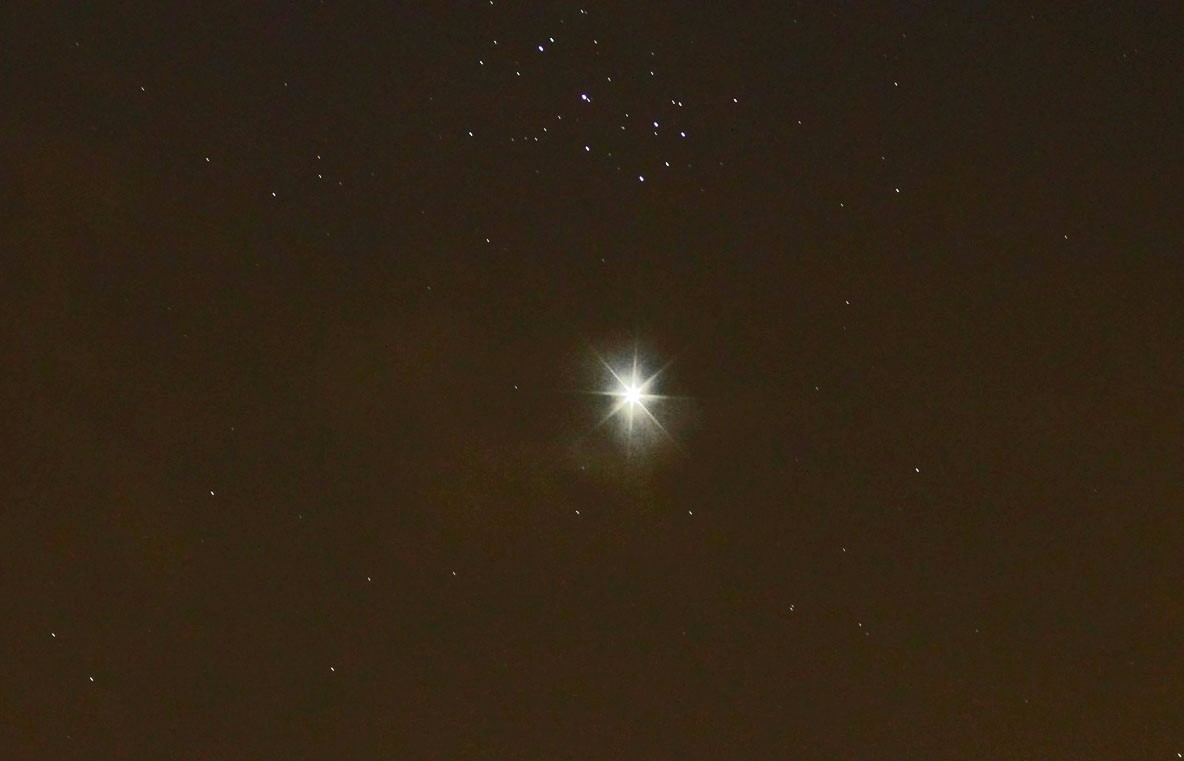 Venus on April 2, near the peak of the current evening apparition, with the Pleaides cluster seen above. Photo by the author.
Venus on April 2, near the peak of the current evening apparition, with the Pleaides cluster seen above. Photo by the author.VENUS EXITS, STAGE WEST
Those of you who have been watching the night sky since last fall have seen Venus rise out of the dusk into a position where it has dominated the western sky for several hours after sunset for the last few months. This all comes to a crashing end in May, as Venus catches up and passes nearly between Earth and Sun.
At the start of May, Venus has dropped noticeably from its peak, but as late as the 9th (first picture below, from Sky & Telescope), it still sets nearly three hours after sunset. This drops to about 2 ¼ hours on the 16th and less than 90 minutes on the 23rd (second and third pictures). By then, you will need to find a spot with an open view to the west-northwest horizon. In another few days Venus will set too early in the dusk to be seen with the naked eye. What day will you last find it? For a challenge, I have posted the scene for the May 30 image 30 minutes earlier, about 8:30 pm. You will almost surely need binoculars, a flat horizon, and very clear skies to glimpse Venus then, through very bright twilight.
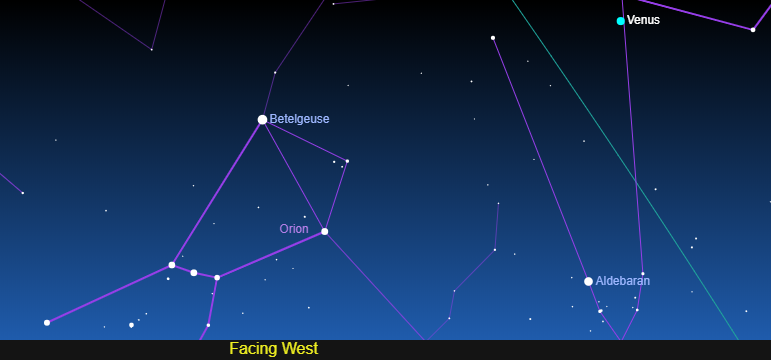 View to West, May 9th, about 9 pm
View to West, May 9th, about 9 pm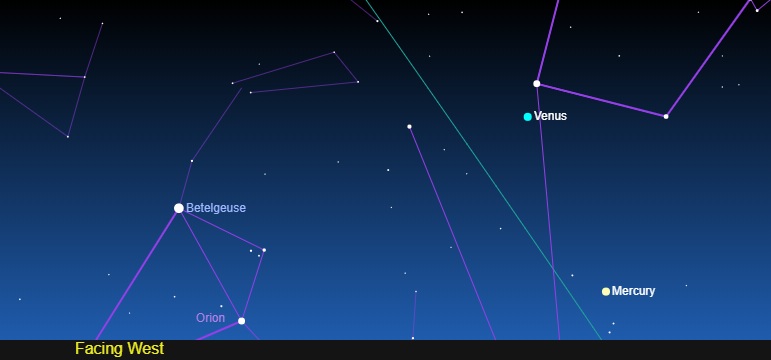 Looking west-northwest, about 9 pm on May 16th. Mercury is now visible to Venus’ lower right
Looking west-northwest, about 9 pm on May 16th. Mercury is now visible to Venus’ lower right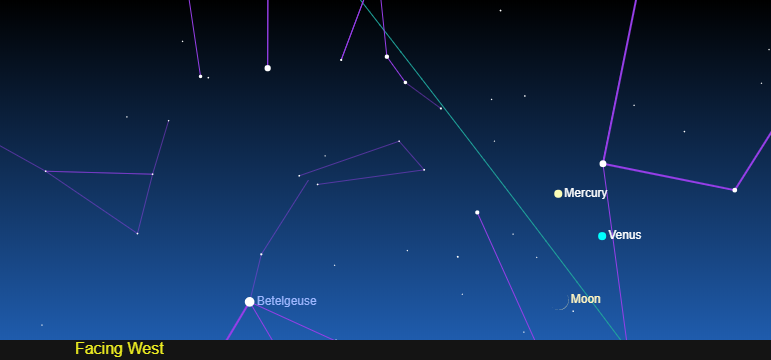 Looking west-northwest, about 9 pm on May 23rd. Fast-rising Mercury has now passed fast-falling Venus. Look for the very thin crescent Moon below Venus- binoculars may help
Looking west-northwest, about 9 pm on May 23rd. Fast-rising Mercury has now passed fast-falling Venus. Look for the very thin crescent Moon below Venus- binoculars may help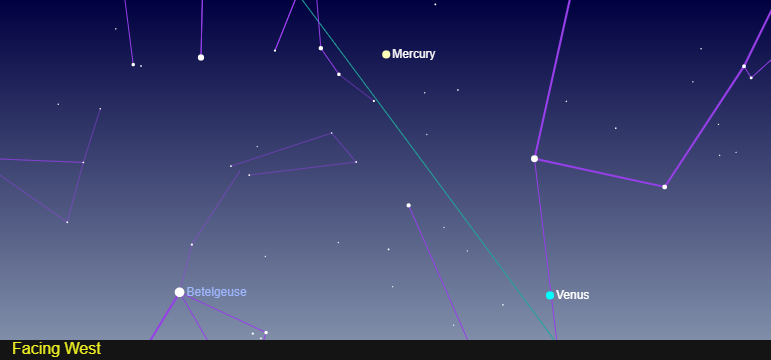 With binoculars, make a last try for Venus in bright twilight. 8:30 pm, May 30 image. All sky maps are from Sky & Telescope magazine
With binoculars, make a last try for Venus in bright twilight. 8:30 pm, May 30 image. All sky maps are from Sky & Telescope magazineVenus will be most nearly between Earth and Sun, called inferior conjunction, on June 3, but miss crossing the Sun’s disk. There is usually no transit for Venus or Mercury because their orbits are tilted relative to the plane of the Earth-Sun line, and so pass just north or south of the Sun. Similarly, there usually is no eclipse at New or Full Moon. I was able to see the Venus transits in 2004 and 2012, but unfortunately almost nobody alive today will be around for the next pair of transits, due in 2117 and 2125. Notice that Venus is joined by Mercury during the second half of May. The two will be closest, about one degree apart, on the nights of the 21st and 22nd- a great chance to use much brighter Venus to help spot the innermost planet. Compared to Venus, Mercury looks like a much dimmer, usually somewhat rosy-colored “star.” On the 23rd, the very thin crescent moon will join the scene- think photo opportunity, if you have a camera and a tripod. Binoculars can help spot Mercury earlier in the twilight or if the night isn’t that clear, and will help spot the Moon that night. Aim your binoculars at Venus and hold them very steady or try to prop them up on something- can you make out Venus’ very thin crescent phase? It is easier in a telescope.
Those few of you who are early risers will continue to be rewarded by not one, not two, but THREE bright planets. Around 5 am, you cannot fail to spot Jupiter shining brightly in the southeast to south, with dimmer but still conspicuous Saturn not far to its left. To me, Saturn’s steady, dull yellow hue suggests its great distance of almost a billion miles from Earth. Farther to the left is increasingly bright Mars, which has a decidedly reddish-orange tint due to its oxidized surface. As can be seen in the last picture, the Moon, waning from gibbous (hump shaped) to crescent, will pass through this area in mid-May, closest to the Jupiter-Saturn pair on the morning of the 12th, and to Mars on the 15th.
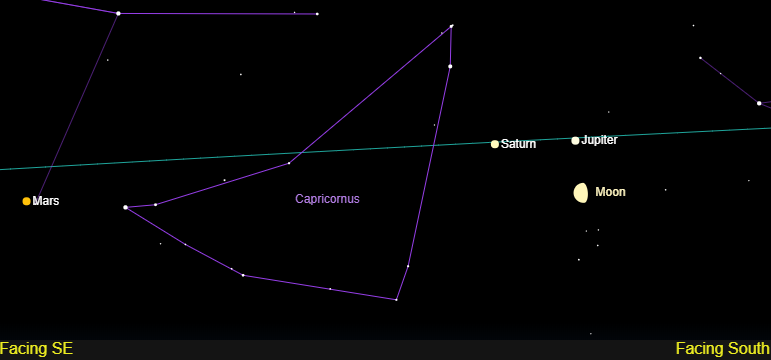 View about 5 am, May 12. The Moon moves through the view for the next three mornings closest to Mars on the 15th.
View about 5 am, May 12. The Moon moves through the view for the next three mornings closest to Mars on the 15th.2020 is a GREAT year for planet-watching, with the fine evening appearance of Venus the first half of the year, including its spectacular exit this month, followed by a good apparition in the morning sky. The second half of 2020 will see our three morning planets gradually make their way into more convenient hours, particularly this fall. Mars will be seen at its best for many years to come, while Jupiter and Saturn will converge in a “Great Conjunction.” Serious stargazers like me are waiting with bated breath for the appearance of Comet SWAN, which might put on a pretty good show in late May and early June. Unfortunately, comets are very unpredictable, often disappointing or even disintegrating before their peak. If SWAN does seem like something that might be impressive to the general public, I will certainly post it here.
Several people have messaged me about a “Smiley Face” involving Venus, Jupiter, and the Moon that is supposed to occur on May 16- but if you read through this blog entry, you can see that the two planets will be about as far apart as can be in the sky- Venus still in the evening and Jupiter before dawn. One of the reasons I am doing this blog is to provide accurate information about events in the sky. We don’t need fake events to make us feel better- the real sky can be a bit of a consolation to us in these difficult times.
SAVE THE DATE! For May, online programming will be available instead of the traditional Gateway to the Stars programs presented at the Gateway Arch. Two programs will be offered on Saturday, May 30 from 8:00 pm – 9:30 pm, Starting at 8:00 pm, the Missouri Chapter of the International Dark-Sky Association will present Lights Out St. Louis,which will discuss the impact of light pollution on migrating birds and practical steps that you can take at home to reduce light pollution, which affects both life on Earth and stargazing. The St. Louis Audubon Society will join the presentation as guests. Starting at 8:45 pm, the St. Louis Astronomical Society will provide Virtual Stargazing at the Gateway Arch. You can catch these Zoom programs if you are a member of these societies, or at the GatewayArchNPS Facebook page via Facebook Live. More details will follow closer to the event.
